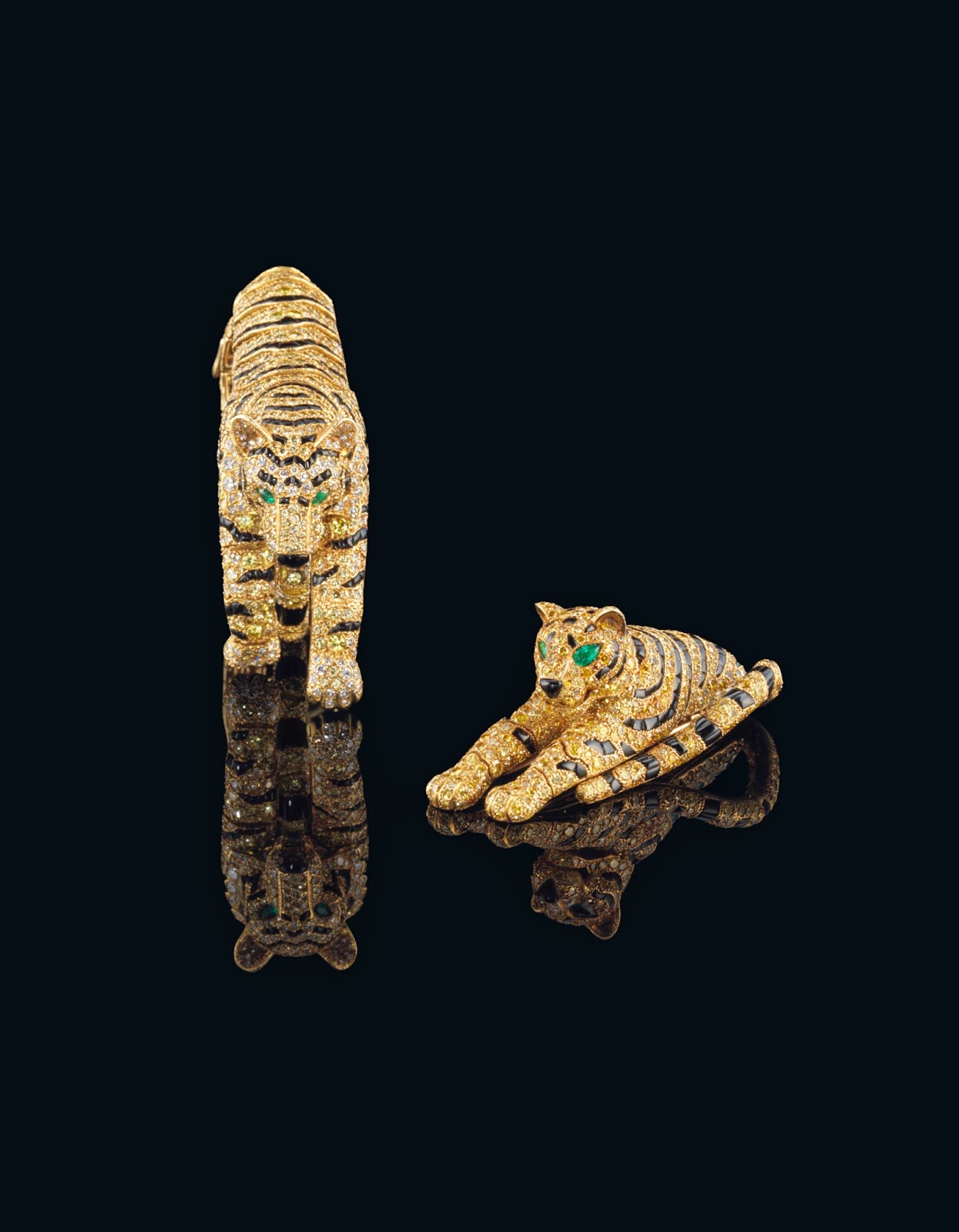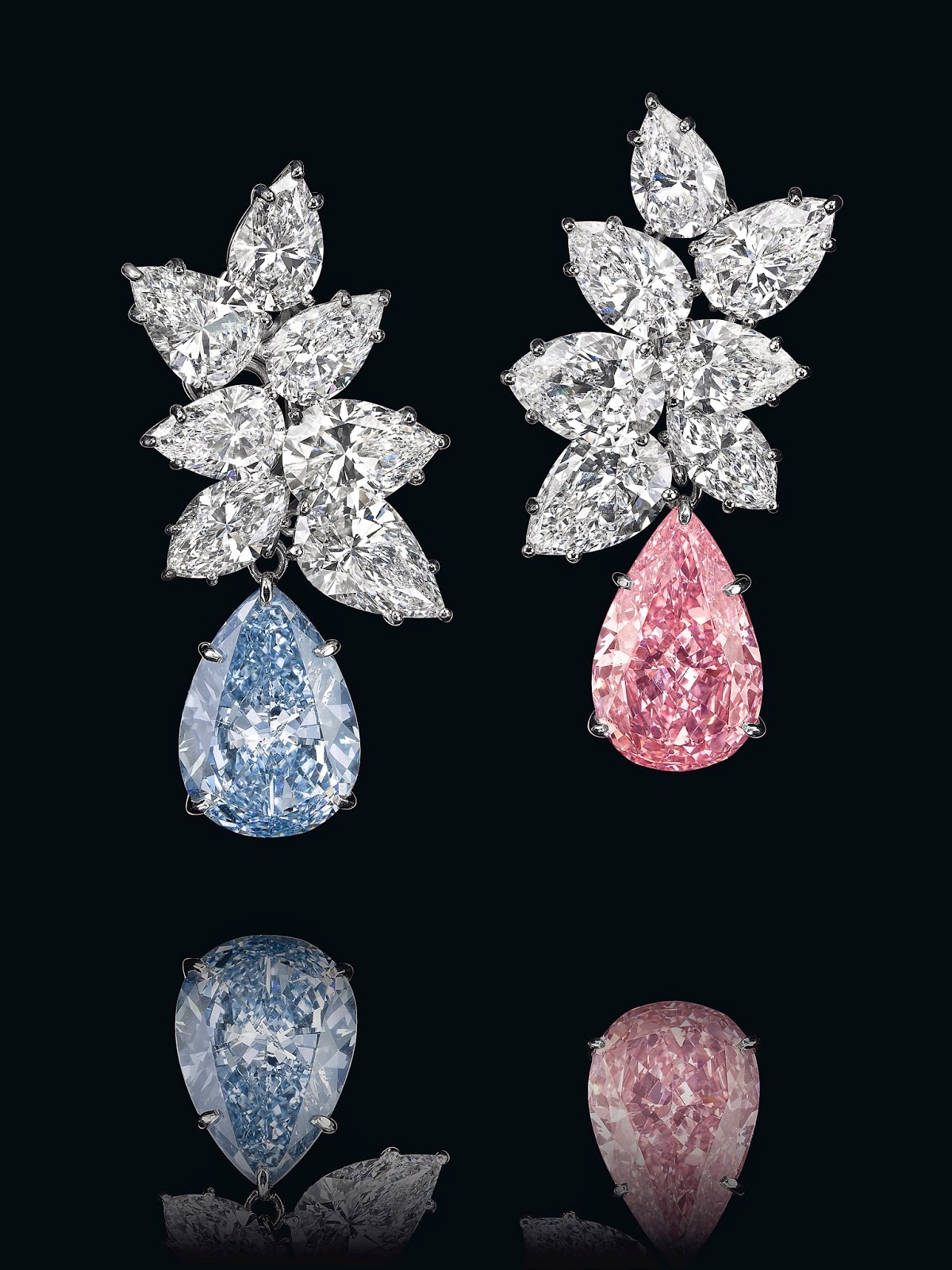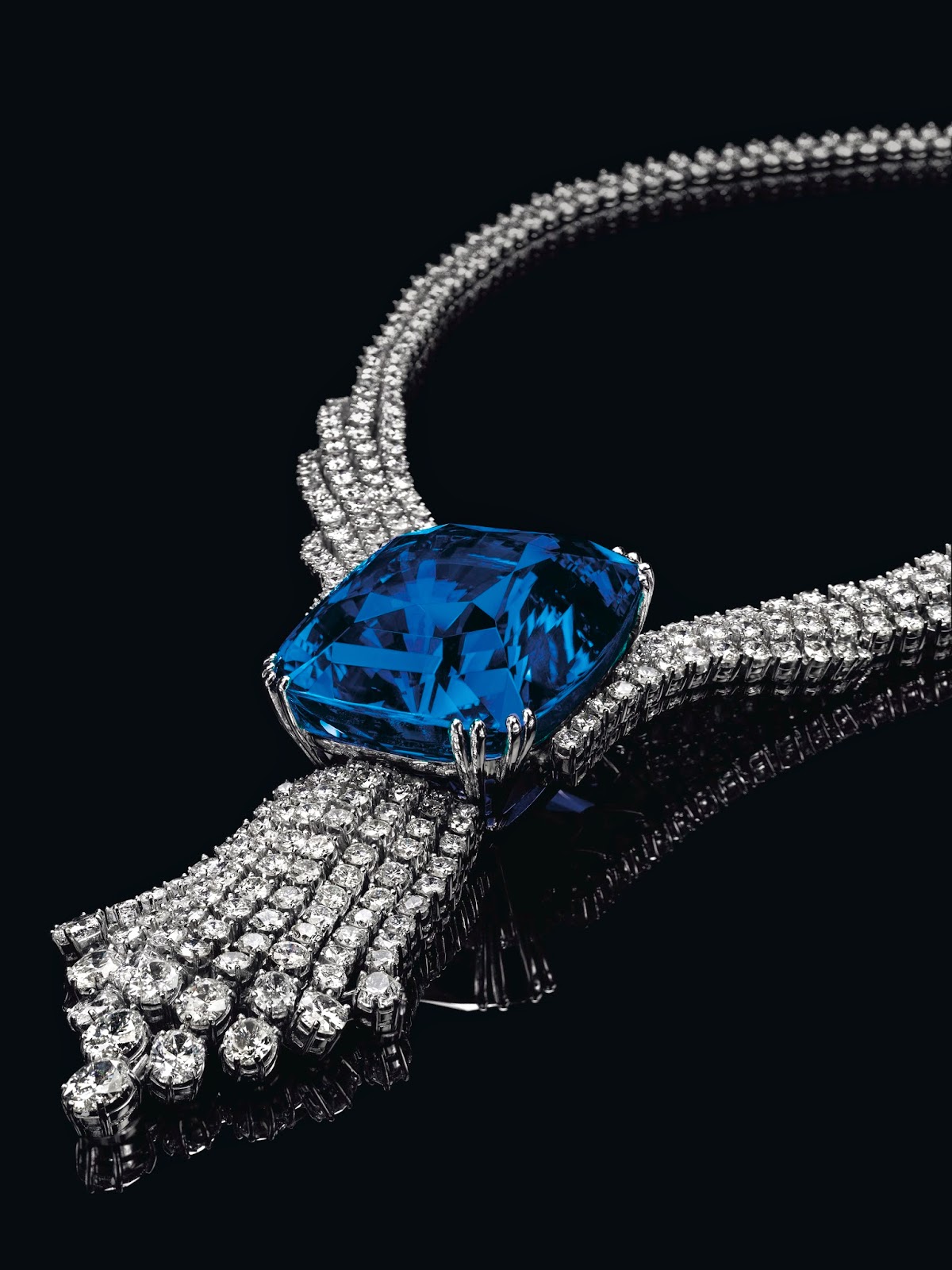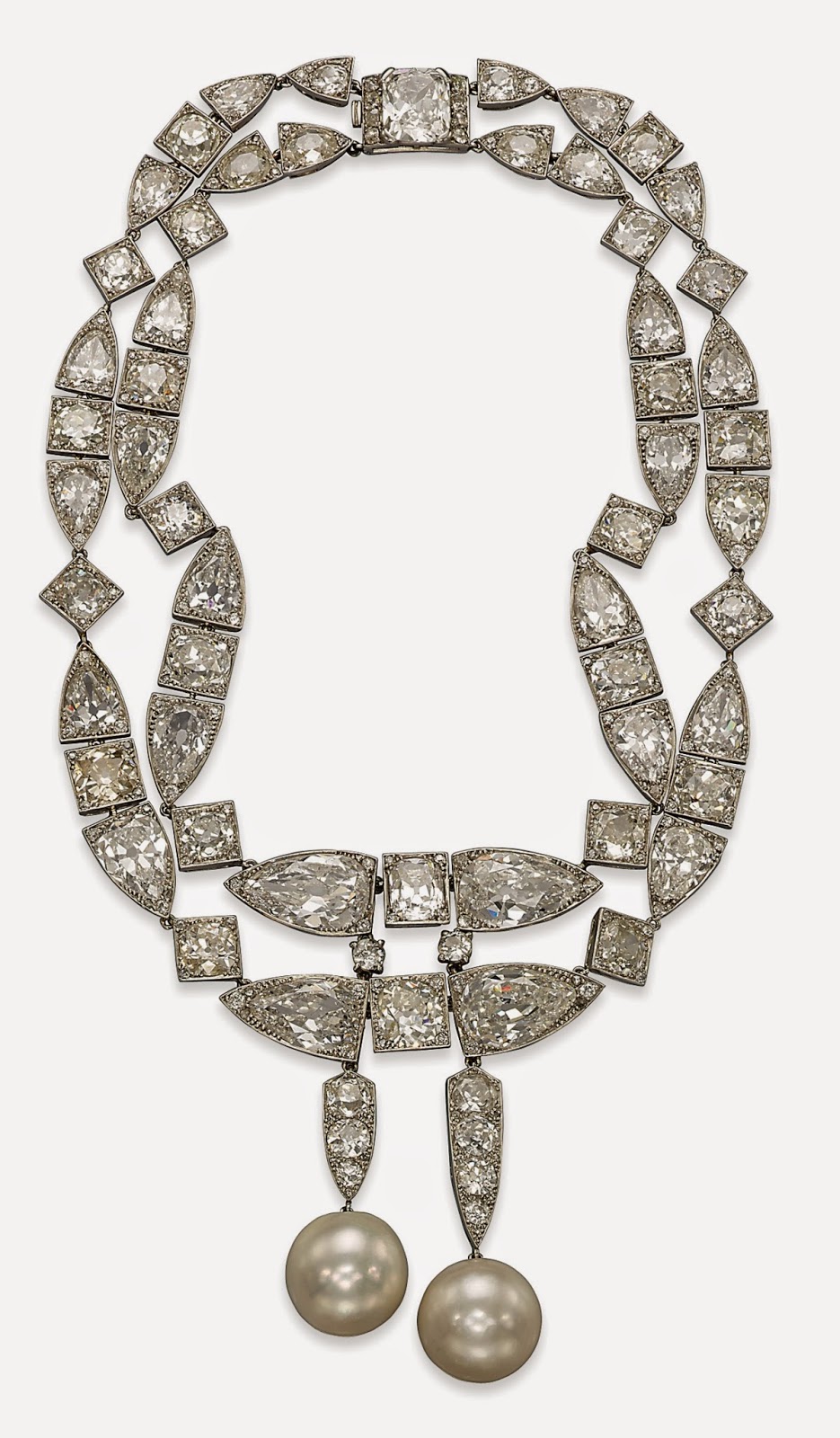![]() |
| Empress Eugenie's Feuilles De Groseillier brooch |
The “
Feuilles de Groseillier” brooch, commissioned in 1855 by Empress Eugenie of France (1826-1920) to French jeweler Alfred Bapst, is one of two statement lots of jewelry with royal provenance to be offered at Christie’s Geneva Magnificent Jewels sale on November 11. Once part of the French Crown Jewels, of which very few examples in original condition have survived, it has an estimate of $2 to $3 million.
The jewel is designed as a cluster of three gold and silver openworked currant leaves with three tassels. It is set throughout with old mine diamonds and is centered with a cushion-shaped mine diamond.
The Parure de Feuilles de Groseillier was originally designed as a guirlande (garland) and worn in multiple ways. In 1870, at the fall of the Second Empire, Empress Eugenie and her husband Napoleon III moved to England, leaving behind most of the Crown Jewels. Seventeen years later, the French government conducted a 12-day auction where all the belongings of the French Royal Family were offered for sale, including the jewelry. Several of the larger pieces were broken up prior to the auction so the stones could be sold individually. The guirlande was sold as eight parts and the present brooch was acquired by Tiffany & Co. The jeweler then gifted the brooch to the Metropolitan Opera of New York as a tribute to the famous opera singer Madame Lucrezia Bori (1887-1960).
![]() |
| Duchess Of Windsor's Cartier Tiger jewels |
The other lot is of British royal provenance. They are two pieces of tiger jewelry by Cartier, formerly from the collection of the Duchess of Windsor. They were given to Sarah Brightman, the world’s best selling soprano, by her then husband Andrew Lloyd Webber, composer and impresario of musical theater. They were a present to her to celebrate the London and Broadway success of “The Phantom of the Opera,” which he wrote and she starred. They were purchased during the legendary sale of Duchess of Windsor’s collection in 1987.
The two tiger pieces comprising of an onyx and diamond clip brooch and bracelet, with emerald eyes, were both made in the 1950s and will be sold as one lot with a combined estimate of $1.8 million to $2.5 million.
The Cartier Tiger Collection has been a highlight of 20th Century jewelry design since it first appeared in 1928. These pieces were bought by the Duke and Duchess of Windsor from Cartier between 1956 and 1959.
Brightman will offer a portion of the proceeds from the sale to The Andrew Lloyd Webber Foundation, which supports the arts, music in schools, The Architectural Heritage Fund and awards 30 performing arts scholarships annually.
![]() |
| Bulgari diamond ear pendant |
While the two items of monarchial heritage are impressive, the top lot for the upcoming sale at the Four Seasons Hotel des Bergues goes to a sparkling pair of Bulgari pear-shaped colored diamond ear-pendants with a pre-sale estimate of $12 million to $15 million.
The ear pendants, which the auction house is calling “A Bulgari Masterpiece,” have marquise and pear-shaped diamond cluster tops weighing approximately 19.28 carats. Suspended from the clusters are a 6.95-carat, pear-shaped fancy vivid blue diamond and a 6.79-carat, pear-shaped fancy vivid pink diamond. Both statement diamonds are detachable. The diamonds are mounted in platinum and gold.
This auction of 390 lots has several other significant colored gems, signature jewels and important natural pearls. Among them are:
![]() |
| The "Blue Belle of Asia" |
* The fourth largest faceted sapphire in the world, the “Blue Belle of Asia,” a cushion shaped Ceylon sapphire of 392.52 carats. It has an estimate of $7 to $10 million. The gem was discovered in 1926 at Pelmadula, Ratnapura (‘The City of Gems’), in Ceylon and was sold to British motor magnate Lord Nuffield (1877-1963), founder of Morris Motors Limited in 1937, according to the auction house. It was rumored that he purchased the sapphire to present to Queen Elizabeth the Queen Mother, on her Coronation Day on May 12, 1937. The gem is suspended on a diamond tassel pendant and attached to a diamond neckchain mounted in gold.
* A 23.66-carat Burmese ruby mounted by Cartier, known as “The Queen of Burma,” was purchased at Cartier in London on November 1937 by the Maharao of Cutch (1866-1942). Its estimate is $5.5 - $7 million. The auction house says the gem “combines all the most sought-after qualities in a ruby: an attractive vivid pinkish red color, an excellent purity, an impressive size and the finest origin.”
* Seven jewels by JAR, some of which were recently on display at the ‘Jewels by JAR’ exhibition at the Metropolitan Museum of Art in New York. Among the group of jewels offered for sale are the ‘Gardenia’ ring, formerly in The Collection of Ellen Barkin ($330,000 - $390,000), the sculpted gold Parrot Tulip cuff ($210,000 - $310,000) and a pair of diamond ‘String’ ear pendants ($140,000 - $200,000).
![]() |
| Art Deco diamond and pearl necklace |
* Formerly in the collection of Baroness Edouard de Rothschild, an Art Deco diamond necklace, suspended with two natural pearls, measuring 16mm each ($700,000 - $1 million).
![]() |
| Harry Winston diamond ear pendants. |
* Diamond ear pendants by Harry Winston with two drop-shaped natural pearls weighing more than 100 grains each ($2.8 - $3.5 million).
* A two-strand natural pearl necklace with rose overtones by Cartier ($530,000 - $850,000).
Please join me on the Jewelry News Network Facebook Page, on Twitter @JewelryNewsNet and on the Forbes website.





















































